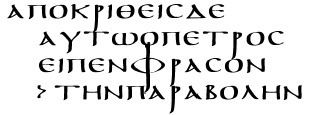Order in the Bible part 1 | Category Gospel | |
 | ||
Matthew 16 is the sixteenth chapter in the Gospel of Matthew in the New Testament section of the Christian Bible. Jesus starts his final journey to Jerusalem ministering through Judea. The narrative can be divided into the following subsections:
Contents
Text
Locations
Matthew 15 ends with Jesus sending the multitude of his followers away and He and his disciples sail to Magdala (or Magadan) on the western shore of the Sea of Galilee. In Matthew 16:1 the Pharisees and Sadducees come to him, presumably in the same location. Theologian John Gill suggests that "these were Galilean Sadducees and Pharisees, of whom mention is made in the Misna".
Matthew 16:5 refers again to travel to "the other side", and verses 16:13-20 are set "in the region of Caesarea Philippi". This location is the furthest point north referred to in Matthew's Gospel, and marks the turning point from which Jesus and his disciples will travel south to Jerusalem.
